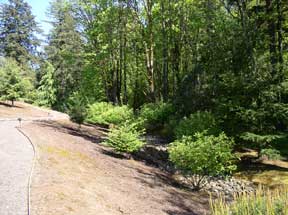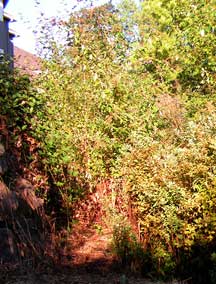 The Powers that Be The Powers that Be
Clean Water Services
Clean Water Services is the sanitary sewer and surface water management
utility for nearly 500,000 customers in urban Washington County and small
portions of Multnomah County, Clackamas County, Lake Oswego, and Portland.
Clean Water Services operates four wastewater treatment plants, constructs
and maintains flood management and water quality projects and manages flow
in the Tualatin River to improve water quality and protect fish habitat. Although
Clean Water Services maintains a close working relationship with Washington
County government, it is a separately managed and financed public utility.
Clean Water Services’ Design & Construction
Standards require developers to protect water resources as they build our
communities through aggressive erosion prevention and sediment control programs,
construction of water quality facilities, and protection and enhancement
of vegetated corridors for water quality sensitive areas.
 How does Clean Water Services protect the water quality of the streams
in the Cedar Mill area from the impacts of development? How does Clean Water Services protect the water quality of the streams
in the Cedar Mill area from the impacts of development?
Cedar Mill includes the steep headwater areas of
Cedar Mill, Johnson, and Golf Creeks and their tributaries. The District’s program for protecting
Water Quality Sensitive Areas like these requires that development set aside
and enhance Vegetated Corridors (also known as “buffers”) along
these streams and other water quality sensitive areas like wetlands.
The width of the vegetated corridor varies based on the type of sensitive
area and the slope of the surrounding area. At a minimum, a 25-foot wide vegetated
corridor in good condition is required along streams, but in steeper terrain,
buffer widths can increase up to 200 feet.
In addition, Clean Water Services requires developers
to build water quality treatment facilities—most commonly swales---that
will treat the stormwater runoff from the impervious surfaces like streets,
sidewalks, and rooftops.
Does Clean Water Services allow developers to put streams into culverts
or fill wetlands to increase buildable area for new housing and commercial
development?
Streams and wetlands are regulated by the Department of State Lands (DSL)
and US Army Corps of Engineers (COE). Although we work closely with the two
agencies, Clean Water Services does not directly regulate streams and wetlands;
our rules focus on the vegetated corridors next to these resources. The COE
and DSL review and issue various permits to alter water quality sensitive
areas after they have completed extensive review; this review includes an
analysis of the resource and alternatives. If DSL or COE allow an impact to
the resource, they generally require mitigation for the impact.
 Who is responsible for maintaining water quality facilities once they
are built? Who is responsible for maintaining water quality facilities once they
are built?
For the first two years after construction, the developer
is responsible for ensuring that the plants in the facility are healthy and
that the facility is functioning. Clean Water Services’ inspection
staff regularly visits newly constructed facilities to make sure the necessary
work is performed. After the first two years, maintenance on almost all of
the facilities built for residential development is done by Clean Water Services.
Some older facilities are maintained by Homeowners Associations (HOA). District
staff is available and frequently responds to requests from HOA or their
landscape maintenance contractors to provide advice and guidance about proper
maintenance practices to ensure that the facilities continue to function
well.
What do builders have to do to protect streams from construction runoff?
What happens if there are erosion problems on a construction site?
Clean Water Services was one of the first jurisdictions in the state to
implement an erosion prevention and sediment control program for construction
activities that disturb 500 square feet or more of area. In addition, construction
sites larger than 1 acre also require a permit from the Oregon Department
of Environmental Quality.
Erosion control on active construction sites can be challenging, especially
during wet weather. Clean Water Services regularly inspects active construction
sites to ensure compliance, and during the winter months, inspections are
made more frequently. We also will respond with an inspector if citizens see
and report a potential problem to us. If a problem is found, the District
uses a combination of education and increasingly severe enforcement tools
to bring a site back into compliance. These tools range from deficiency notices
to Stop Work Orders to Civil Citations with fines up to $1000 per day per
violation.
Instead of treating stormwater once it runs off
a site, wouldn’t
using Low Impact Development to reduce the amount of stormwater from
a site be a better option?
Low Impact Development (LID) is another approach to managing stormwater
runoff. It has advantages and challenges, and so using it on every single
development may not be appropriate.
The purpose of Low Impact Development is to reduce the impact that development
has on natural resources including creeks, streams, and wetlands. As it applies
to stormwater, developments using Low Impact Development Approaches (LIDA)
use different building techniques or materials to reduce the amount of stormwater
that is generated from a site. The most common methods for reducing the amount
of stormwater include reducing the amount of total impervious surface, using
infiltration systems, and occasionally by retaining rainwater and re-using
it for irrigation or other beneficial uses.
Within Washington County, there is growing interest
in using LIDA on new developments. However, these techniques are still relatively
new and untested here. Developers, design engineers, and local governments
do not have a lot of direct experience implementing low impact development
or know how it would work over time. In addition, since many of the techniques
are focused at the source – meaning individual homeowners have to be responsible for maintaining
them forever – education and good designs are critical. Our soil types
make designing infiltration systems a bit more challenging; we don’t
want to have standing water around people’s houses; and we don’t
want to surprise future homeowners about their responsibilities.
How is Clean Water Services promoting Low Impact Development?
Clean Water Services, along with the cities in Washington
County and the County itself are taking an active role in providing design
opportunities and education for engineers, permit reviewers, site inspectors,
contractors, and maintenance crews. The 2007 update of the Design & Construction
Standards now includes a list of low impact development techniques that will
be allowed. Staff is currently working on several proposed pilot projects
(although none currently in the Cedar Mill area), advising developers on
how they might use LID techniques, and assisting with informational guidelines
that will encourage them.
What about existing, older developments? What is being done to treat
stormwater runoff from those sites?
The regulations to treat stormwater with onsite water
quality facilities have been in effect since 1992. District staff and developers
are seeking opportunities to retrofit areas developed before then. The District’s
rules also require treatment for any site that redevelops, even if no
additional impervious surface is being added.
During the fiscal year 2007-2008, Clean Water Services will be embarking
on a master planning effort to identify potential retrofit sites. We have
also been working in conjunction with the cities and County to retrofit several
stormwater outfalls throughout the county to provide water quality treatment.
How can Cedar Mill residents provide input on
Clean Water Services’ rules,
projects and policies?
All stakeholders including Cedar Mill residents are
encouraged to participate in the District’s decision-making via public
open houses, neighborhood project meetings, stakeholder dialogues, Clean
Water Advisory Commission and Board of Director meetings, and by contacting
staff when they have a suggestion or concern.
|
